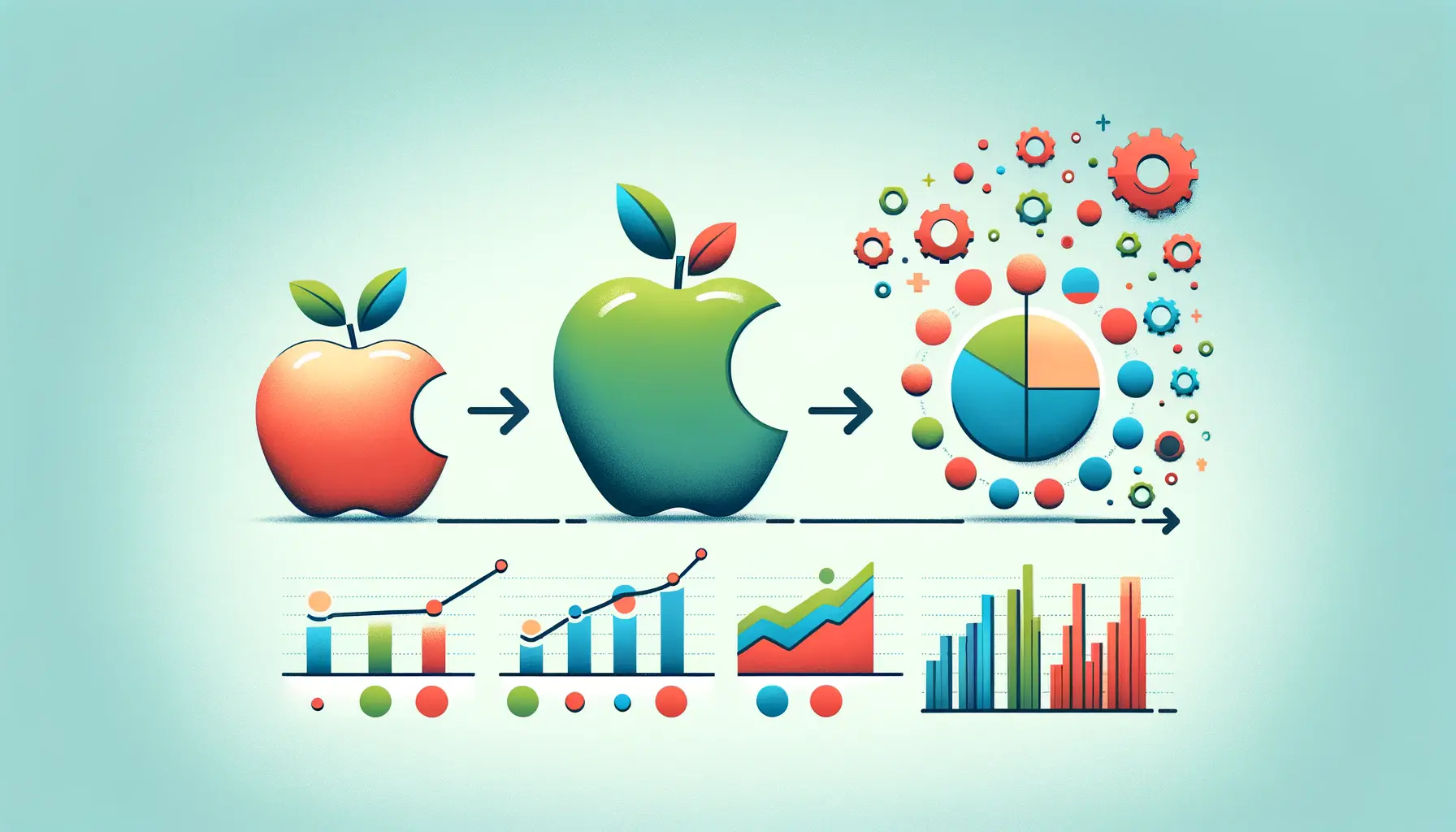Apple Search Ads have emerged as a pivotal tool for app developers and marketers aiming to enhance visibility in a highly competitive digital marketplace.
With millions of apps vying for attention on the App Store, effective cost management in Apple Search Ads is not just a strategy, but a necessity for achieving sustainable success.
This comprehensive guide delves into the nuances of managing costs while maximizing the impact of your campaigns on Apple’s platform.
Understanding the intricacies of Apple Search Ads is crucial for developers and advertisers.
It’s a realm where strategic bidding, audience targeting, and creative optimization converge to drive app downloads and engagement.
This article will explore the various facets of cost management in Apple Search Ads, offering insights and strategies to optimize your advertising spend.
- Understanding Apple Search Ads and Its Importance
- Strategies for Optimizing Campaigns
- Managing Budgets and Costs
- Advanced Features and Tools in Apple Search Ads
- Measuring and Analyzing Campaign Performance
- Best Practices for Apple Search Ads
- Challenges and Solutions in Apple Search Ads
- Conclusion: Mastering Cost Management in Apple Search Ads
- FAQs on Cost Management in Apple Search Ads
Understanding Apple Search Ads and Its Importance
Apple Search Ads is a powerful advertising platform that allows app developers to place their apps at the top of App Store search results.
This visibility is critical, considering that a significant portion of app downloads originates from search queries.
By leveraging Apple Search Ads, developers can significantly increase their app’s discoverability, directly influencing download numbers and overall app success.
However, diving into Apple Search Ads without a solid understanding of its cost structure can lead to inefficient spending and suboptimal results.
The platform operates on a cost-per-tap (CPT) model, meaning advertisers pay each time a user taps on their ad.
This model emphasizes the importance of targeting the right audience and crafting compelling ad creatives to ensure that every tap counts.
Key Metrics in Apple Search Ads
Several key metrics are essential for understanding and managing costs in Apple Search Ads.
The Cost Per Tap (CPT) is a primary metric, indicating the average cost incurred each time a user taps on an ad.
Another crucial metric is the Cost Per Acquisition (CPA), which reflects the average cost of acquiring a new user who installs the app after tapping the ad.
Monitoring these metrics helps advertisers make informed decisions about their bidding strategies and budget allocation.
Additionally, the Tap Through Rate (TTR) and Conversion Rate (CR) are vital indicators of ad effectiveness.
TTR measures how often users tap on an ad after seeing it, while CR tracks how many of those taps result in an app install.
High TTR and CR values suggest that the ad is relevant and appealing to the target audience, a key factor in cost-effective Apple Search Ads campaigns.
Effective cost management in Apple Search Ads hinges on understanding and optimizing key metrics like CPT, CPA, TTR, and CR.
Strategies for Optimizing Campaigns
Optimizing campaigns in Apple Search Ads is crucial for managing costs effectively.
This involves a combination of strategic bidding, audience targeting, and creative adjustments.
Here, we’ll explore several strategies that can help you optimize your campaigns for better performance and cost efficiency.
Bidding Strategies
Understanding and implementing the right bidding strategies is fundamental to cost management in Apple Search Ads.
A well-thought-out bidding approach can significantly impact your campaign’s success and overall expenditure.
- Cost-Per-Tap (CPT) Bidding: Set a maximum CPT bid to control how much you pay for each tap. It’s essential to balance between bidding high enough to win ad placements and low enough to maintain cost efficiency.
- Cost-Per-Acquisition (CPA) Goals: Setting a CPA goal helps in managing the overall cost of acquiring new users. This involves setting a cap on the amount you’re willing to pay for each installation.
- Dynamic Bidding: Utilize Apple’s automated bidding system to adjust your bids in real-time based on the likelihood of conversion. This can help in optimizing ad spend for the best possible outcomes.
Targeting the Right Audience
Effective audience targeting ensures that your ads are seen by users most likely to be interested in your app, thus improving the chances of conversion and better managing costs.
- Demographic Targeting: Tailor your ads to specific age groups, genders, or locations to reach the most relevant audience.
- Behavioral Targeting: Target users based on their app usage patterns, preferences, and interests for more personalized ad experiences.
- Keyword Targeting: Use relevant keywords that potential users might search for. This includes broad, exact, and negative keyword match types to refine your targeting.
Creative Optimization
The creative elements of your ad, including the title, description, and visuals, play a significant role in attracting users and can impact the cost-effectiveness of your campaigns.
- A/B Testing: Experiment with different ad creatives to see which ones resonate most with your target audience.
- Ad Relevance: Ensure that your ad creatives are closely aligned with the search intent of your target audience.
- Seasonal Adjustments: Update your ad creatives to reflect current events, holidays, or seasons to maintain relevance and engagement.
By combining strategic bidding, precise audience targeting, and creative optimization, advertisers can significantly enhance the efficiency of their Apple Search Ads campaigns.
Managing Budgets and Costs
Effective budget management is a cornerstone of cost control in Apple Search Ads.
It involves setting and adjusting budgets to align with your marketing goals and financial constraints.
Here, we’ll discuss various approaches to managing your advertising budget and controlling costs.
Daily and Lifetime Budgets
Apple Search Ads offers flexibility in budgeting with options for both daily and lifetime budgets.
Understanding and utilizing these options can help in maintaining control over your ad spend.
- Daily Budgets: Set a maximum amount to spend per day. This helps in spreading your budget evenly across the campaign duration and prevents overspending.
- Lifetime Budgets: For campaigns with a specific end date, setting a lifetime budget ensures that your total spend does not exceed a predetermined amount.
Cost Control Mechanisms
Apple Search Ads provides several mechanisms to help advertisers control costs and optimize spending.
- Cost-Per-Tap (CPT) Cap: Setting a CPT cap ensures that you do not pay more than a specified amount for each tap, helping to control costs per user engagement.
- Cost-Per-Acquisition (CPA) Cap: A CPA cap limits the amount you’re willing to spend on acquiring a new user, ensuring that your acquisition costs align with your budget.
- Adjusting Bids: Regularly review and adjust your bids based on campaign performance and market dynamics to optimize spending.
Monitoring and Adjusting Campaigns
Continuous monitoring and timely adjustments are vital for managing budgets effectively in Apple Search Ads.
- Performance Tracking: Regularly track key metrics like CPT, CPA, TTR, and CR to gauge campaign performance and identify areas for improvement.
- Budget Reallocations: Shift budgets between campaigns or ad groups based on their performance to maximize returns on your ad spend.
- Seasonal Adjustments: Consider increasing your budget during peak seasons or promotional periods when user engagement is likely to be higher.
Regular monitoring and strategic adjustments in budgeting and bidding are essential for maintaining cost efficiency in Apple Search Ads campaigns.
Advanced Features and Tools in Apple Search Ads
Apple Search Ads offers a suite of advanced features and tools designed to enhance campaign performance and cost efficiency.
These features enable advertisers to fine-tune their campaigns for optimal results.
Let’s explore some of these advanced capabilities and how they can be leveraged for effective cost management.
Campaign Management API
The Apple Search Ads Campaign Management API is a powerful tool for advertisers who manage large-scale campaigns.
It allows for the automation of various campaign management tasks, including bid adjustments, budgeting, and reporting.
- Automated Bid Adjustments: Use the API to automate bid adjustments based on predefined criteria, ensuring optimal bidding round the clock.
- Bulk Operations: Manage multiple campaigns simultaneously, saving time and ensuring consistency across your advertising efforts.
- Custom Reporting: Generate tailored reports that focus on specific metrics and insights relevant to your campaign goals.
Search Match Feature
Search Match is an Apple Search Ads feature that automatically matches your ads with relevant user search queries.
This feature can be a powerful tool for discovering new keywords and reaching a broader audience.
- Keyword Discovery: Uncover new, relevant keywords that you might not have considered, expanding your campaign’s reach.
- Increased Visibility: Gain exposure for your app in search queries that are closely related to your app’s content and features.
Creative Sets
Creative Sets allow advertisers to use different combinations of screenshots and app previews to create more relevant and engaging ads for different audience segments.
- Targeted Messaging: Tailor your ad creatives to match the interests and preferences of different user segments.
- A/B Testing: Experiment with various creative combinations to determine which ones resonate best with your target audience.
Attribution API
The Apple Ads Attribution API helps advertisers track user actions after interacting with an ad, providing valuable insights into the user journey and conversion process.
- Conversion Tracking: Understand how users interact with your app after installing it through Apple Search Ads.
- ROI Analysis: Measure the return on investment of your campaigns by tracking post-install actions and conversions.
Measuring and Analyzing Campaign Performance
Measuring and analyzing the performance of your Apple Search Ads campaigns is crucial for effective cost management.
By understanding which aspects of your campaigns are performing well and which are not, you can make informed decisions to optimize your ad spend.
Let’s delve into the key metrics and analysis techniques that can guide your campaign optimization efforts.
Key Performance Metrics
Several metrics are vital for evaluating the performance of your Apple Search Ads campaigns.
These metrics provide insights into how users are interacting with your ads and the overall effectiveness of your campaigns.
- Cost Per Tap (CPT): Measures the average cost for each tap on your ad, indicating the immediate engagement cost.
- Cost Per Acquisition (CPA): Reflects the average cost of acquiring a user who installs your app, a critical metric for ROI analysis.
- Tap Through Rate (TTR): The percentage of times users tapped on your ad after seeing it, indicating ad relevance and appeal.
- Conversion Rate (CR): The percentage of taps that result in an app install, crucial for understanding the effectiveness of your ad in driving actual installs.
Utilizing Analytics Tools
Apple Search Ads provides a range of analytics tools that can help you dive deep into your campaign performance.
These tools offer various data points and visualizations to aid in your analysis.
- Dashboard Overview: Get a quick snapshot of your campaign performance, including key metrics like CPT, CPA, TTR, and CR.
- Custom Reports: Create custom reports tailored to your specific needs, focusing on the metrics that matter most to your campaigns.
- Trend Analysis: Analyze performance trends over time to identify patterns, seasonal effects, or other factors influencing your campaign results.
Optimizing Based on Data Insights
Data-driven insights are invaluable for optimizing your Apple Search Ads campaigns.
By analyzing performance data, you can make strategic adjustments to improve efficiency and effectiveness.
- Bid Adjustments: Modify your bids based on performance data to ensure you’re investing appropriately in high-performing keywords and audiences.
- Creative Optimization: Refine your ad creatives based on which versions are resonating most with your target audience.
- Audience Refinement: Adjust your targeting parameters based on which audience segments are showing the most engagement and conversions.
Accurate measurement and analysis of campaign performance are essential for optimizing Apple Search Ads, ensuring you get the best return on your advertising investment.
Best Practices for Apple Search Ads
Adopting best practices in Apple Search Ads not only enhances campaign performance but also ensures efficient cost management.
These practices are distilled from successful campaigns and industry insights, offering a roadmap to optimize your advertising efforts.
Let’s explore some of these best practices.
Keyword Optimization
Keywords are the cornerstone of success in Apple Search Ads.
Selecting the right keywords and continuously optimizing them is crucial for reaching the right audience.
- Relevance: Choose keywords that are highly relevant to your app. This increases the likelihood of your ad being shown to interested users.
- Search Volume: Target keywords with a significant search volume to ensure your ads reach a broader audience.
- Competition: Be mindful of keyword competition. Highly competitive keywords may drive up costs, so balance them with less competitive, niche keywords.
Ad Creative Excellence
The creative elements of your ad play a significant role in attracting users.
Ensuring that your ad creatives are engaging and relevant is key to campaign success.
- Visual Appeal: Use high-quality images and videos that capture attention and convey your app’s value proposition effectively.
- Clear Messaging: Your ad copy should be concise, clear, and compelling, encouraging users to tap and download.
- A/B Testing: Regularly test different creative variations to determine what works best with your target audience.
Continuous Learning and Adaptation
The digital advertising landscape is dynamic, and so should be your approach to Apple Search Ads.
Continuously learning from your campaigns and adapting your strategies is vital for long-term success.
- Performance Analysis: Regularly review your campaign performance and learn from both successes and failures.
- Market Trends: Stay updated with the latest trends in digital advertising and user behavior to keep your campaigns relevant.
- Feedback Loop: Use insights from your campaigns to refine your overall app marketing strategy, including App Store Optimization (ASO).
Embracing best practices in keyword optimization, ad creative design, and continuous learning can significantly enhance the effectiveness and cost-efficiency of your Apple Search Ads campaigns.
Challenges and Solutions in Apple Search Ads
While Apple Search Ads offer a robust platform for app promotion, advertisers often face challenges that can impact the cost-effectiveness and performance of their campaigns.
Understanding these challenges and knowing how to address them is crucial for successful advertising on this platform.
High Competition and Rising Costs
One of the significant challenges in Apple Search Ads is the high level of competition, especially in popular app categories.
This competition can lead to rising costs and bidding wars.
- Strategic Bidding: Employ strategic bidding techniques, such as adjusting bids based on performance and using CPA goals to control costs.
- Niche Targeting: Focus on niche keywords and audience segments to find less competitive spaces where your app can stand out.
Maintaining Ad Relevance
Ensuring that your ads remain relevant to your target audience is crucial for maintaining high engagement and conversion rates.
- Regular Updates: Continuously update your ad creatives and messaging to align with current trends and user preferences.
- User Feedback: Incorporate user feedback and app reviews to refine your ad content, making it more appealing to potential users.
Tracking and Attribution
Accurately tracking user actions and attributing conversions can be challenging, yet it’s essential for understanding the ROI of your campaigns.
- Utilize Apple’s Tools: Leverage Apple’s Attribution API and other in-built tools to track user actions and measure campaign effectiveness.
- Third-Party Analytics: Consider integrating third-party analytics platforms for deeper insights and more comprehensive attribution data.
Adapting to Market Changes
The mobile app market is dynamic, with frequent changes in user behavior, technology, and market trends.
Adapting to these changes is key to maintaining campaign effectiveness.
- Market Research: Stay informed about market trends and shifts in user behavior to keep your campaigns relevant and effective.
- Flexible Strategies: Be prepared to pivot your strategies and experiment with new approaches in response to market changes.
Ignoring the challenges in Apple Search Ads can lead to inefficient spending and reduced campaign effectiveness. Addressing these challenges proactively is essential for successful advertising on the platform.
Conclusion: Mastering Cost Management in Apple Search Ads
In the realm of digital marketing, particularly within the App Store’s competitive landscape, mastering cost management in Apple Search Ads is not just a strategy, but a necessity for success.
The journey through Apple Search Ads is one of strategic planning, continuous learning, and adaptation.
By understanding the nuances of cost management and leveraging the platform’s robust features, advertisers can significantly enhance the visibility and success of their apps.
Key Takeaways for Effective Cost Management
Effective cost management in Apple Search Ads hinges on several key factors:
- Strategic bidding and budgeting to maximize ROI while minimizing unnecessary expenditure.
- Targeting the right audience with relevant, engaging ad creatives to ensure high conversion rates.
- Continuous monitoring and optimization of campaigns based on performance data and market trends.
Moreover, overcoming challenges such as high competition, maintaining ad relevance, and adapting to market changes are crucial for the long-term success of your campaigns.
By addressing these challenges proactively, advertisers can maintain a competitive edge in the dynamic App Store environment.
Final Thoughts on Apple Search Ads
Apple Search Ads offer a unique opportunity for app developers and marketers to reach their target audience effectively.
However, the key to success lies in a deep understanding of the platform’s mechanics and a commitment to ongoing optimization and adaptation.
By embracing best practices, leveraging advanced tools, and staying agile in the face of market changes, advertisers can achieve not only effective cost management but also substantial growth and success in their app marketing endeavors.
In conclusion, the journey through Apple Search Ads is an evolving process of learning, testing, and refining strategies.
With the right approach, tools, and mindset, advertisers can unlock the full potential of their apps, turning visibility into downloads and downloads into lasting user engagement.
If you're seeking expertise in Apple Search Ads campaigns, visit our service page for professional management!
FAQs on Cost Management in Apple Search Ads
Explore these frequently asked questions to gain deeper insights into managing costs effectively in Apple Search Ads.
In the second half of 2022, the average CPT for Apple Search Ads was approximately $1.99, reflecting the cost for each user tap on an ad.
CPA in Apple Search Ads represents the average cost of acquiring a user who installs the app after tapping the ad, crucial for ROI analysis.
Yes, Apple Search Ads allows setting a daily budget, enabling advertisers to control their ad spend effectively each day.
Effective bidding practices include strategic CPT bidding, setting CPA goals, and utilizing Apple’s automated bidding system for optimization.
Optimize keywords by focusing on relevance, targeting high search volume keywords, and balancing between competitive and niche keywords.
Ad creatives are crucial for attracting users, requiring high-quality visuals and clear messaging that resonates with the target audience.
Use Apple’s Attribution API and other in-built tools for tracking user actions and measuring campaign effectiveness accurately.
Stay informed about market trends, be flexible in strategy, and be prepared to pivot your approach in response to market dynamics.










